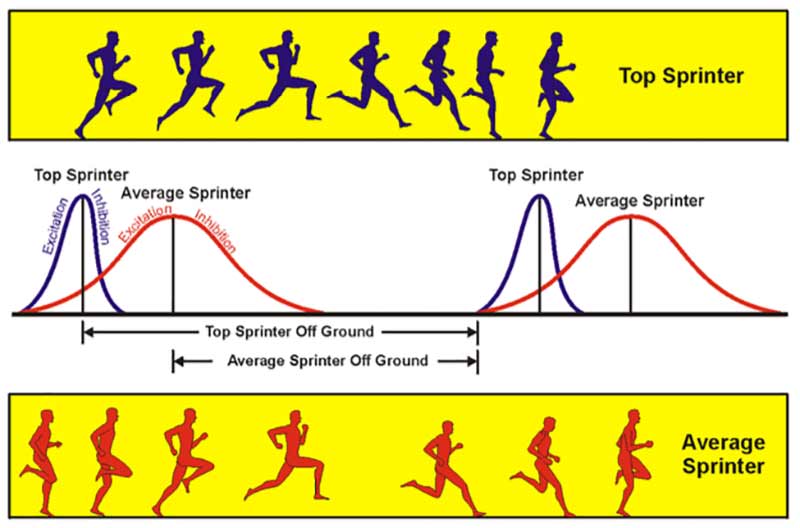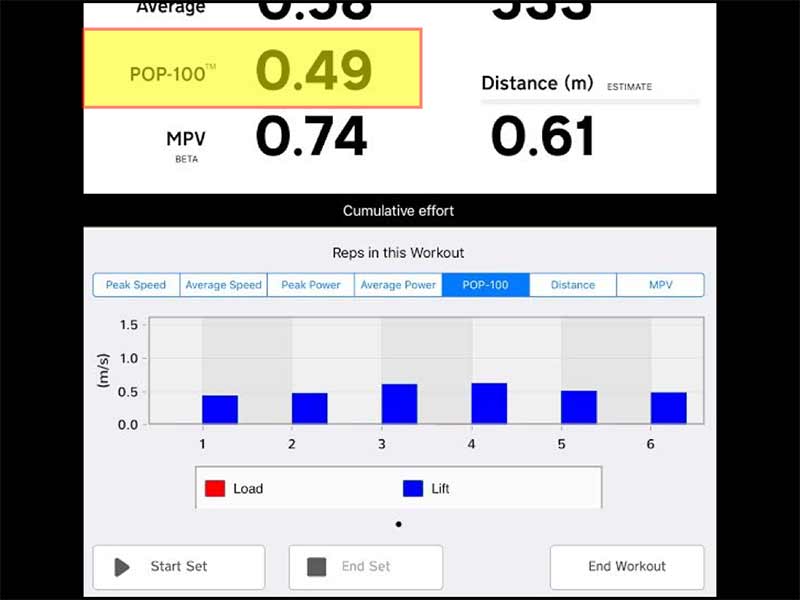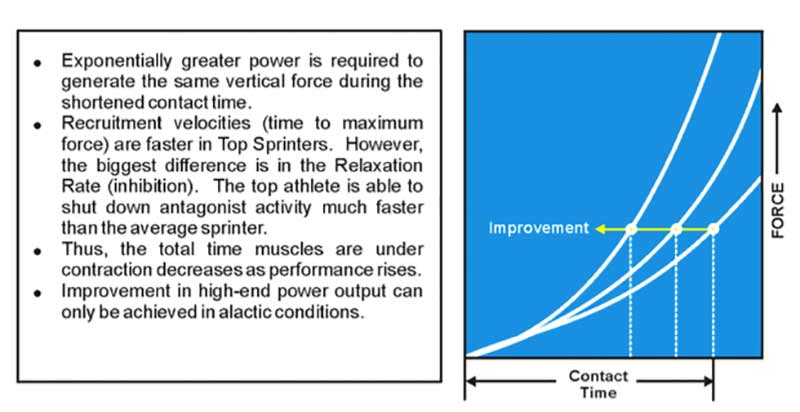[mashshare]

Editor’s Note: This is the first of a series of articles showing how deeper metrics of bar tracking technology can improve the quality of training in the weight room.
Coaches use the weight room to make athletes better. One of the most precious qualities that can emerge is first-step quickness, or explosiveness. In previous articles on Freelap and other sites, I have shown that velocity based training (VBT) is becoming mainstream, with the goal of improving performance on the field or court. Along with managing power and monitoring fatigue, VBT can profile specific traits. While VBT in its early form is a great starting point and solution, the problem with barbell speed alone is that it does NOT always equate to body speed.
The Beyond Bar Speed series is about embracing what coaches have applied to this point and laying the foundation of what should be considered next—understanding, assessing, and applying RFD (rate of force development). This first article provides three important takeaways related to this crown jewel:
- What is RFD in the real world?
- How does it help athletes?
- How can you adjust training programs to improve it?
How RFD contributes to athletic performance
Rate of force qualities in strength and conditioning provide a wide range of possibilities. A practical way of getting the best bang for your buck is to look at the primary benefit.
Overcoming inertia is the cornerstone of most sports; the slowest movement can make/break success. Share on XInstead of first step quickness, it’s better to think in terms of overcoming inertia. Overcoming inertia or momentum can mean starting from a dead stop or a change of direction.
A simple example illustrates the importance of RFD. The first 5 meters in a sprint are always the slowest, as the starting point is a dead start or stationary period of no motion. The first three steps are slow because gravity always must be paid up front with power to get going. Some athletes are effective early in motion while others require more time to get up to speed. Rate of force production doesn’t exactly equate to how fast one can move early. It does equate significantly to being fast off the snap in American football, and can help in other sports as well. Besides performance, RFD is a major player in protecting athletes from injuries. Many movements with fast actions require the body to act quickly before excessive motions can damage tendons and ligaments.

Something to think about: sport demands may be in time frames earlier than full speed and power. This comes back to the point of making sure training prepares for the demands of the sport. Comprehensive evaluation, including peak and average bar speed, need to be dissected to reveal what is happening in applied or “real world” settings.
One of my favorite examples of RFD in action is ground contact times for sprinters. While it is more complicated than just doing jump and weight training, most elite sprinters quickly deliver a lot of energy into the ground and if all works out, do it over and over.
Jumping high and far is not the same as jumping fast. Many sports need an athlete to have a high-level combination of two important qualities: the ability to displace oneself maximally and get to the ball or opponent quickly. For example, NBA rebounders are not just great jumpers. They can jump repeatedly and jump fast to get to the ball first.
RFD is not just about sprinting or jumping. It’s part of the responsibility for fatigue and power management as well as a way to dissect assessment of power for more granularity and effective programming. RFD is a valuable asset, and coaches can gauge their training design better if they understand it and test it properly.
Why RFD Measurement is Controversial
Bring up RFD with some sport scientists and you will get a mixed bag of opinions. The use of RFD in the research is not easy to assess because it’s such a sensitive measure. It can be worthless if not sampled properly with the right testing protocol and the right interpretation. RFD sounds like a subcomponent of power, but it’s in the middle of the spectrum—not a particular location on the force-time curve I discussed in my article on force plates. It’s important to know the simple expression of power and when it shows up on the field or in the weight room. We will start with something comfortable like a simple vertical jump, and then dig deeper into how it relates to other exercises and measurement tools.
On the force-time curve, the rate of change of force is what one is measuring. This requires precise instrumentation and interpretation. When you think RFD, think about how steep the acceleration is—usually the earlier, the higher. Sometimes athletes gather force slower as they care about what happens at the end of the movement, sort of like pitchers moving from slow to fast. Summation of forces uses the time and distance during the preparatory phases of absolute performance, similar to throws in track and field. Some actions in sport simply don’t have time to work with, and the absolute amount of force isn’t as important as the rate that a percentage of that force can be used. Thousands of American football players are stronger that Usain Bolt, but nobody with the same RFD qualities creates better relative forces into the ground at high speed.
A common argument against RFD use in testing athletes is the reliability of the data, but not the value of the quality of sport performance. The most common problem with RFD is the vague and general use of the term. Just like barbell speed, RFD alone as a quality doesn’t move the needle much as RFD is so specific. Even peak RFD is so vague and poor an indicator that I would not suggest using it. To properly use RFD, the exercise must be properly executed, the precision must be high, and the magnitude of change must show up so well that it passes the coaching eyeball test (not visual, but clear data that doesn’t require a statistical package to decipher).
Sampling RFD is easy when you know what you are looking for. I like early motion measurement, as well as the end, and how they connect in the middle. RFD sampling can range from the first 0-50 milliseconds to 0-100 or 0-250. To understand—or better yet, appreciate—those small time frames, think about what goes on in such a short period. A stride contact in sprinting lasts about 80 milliseconds. That means the foot touches the ground, transfers forces, and is off before the blink of an eye. RFD is usually a fraction of that time period, as the athlete must overcome gravity eccentrically and then produce propulsive forces. RFD is sampled during part of the second phase of the contact period, and that is how winners and losers in sprinting are truly measured. The good news is that RFD is slightly trainable—it’s a stubborn genetic quality—and can be improved by patient and quality programming.
How to Measure RFD Qualities Practically
I have read a lot of RFD articles and some research studies that frankly wasted my Sunday morning education time. I don’t care about stuff that looks at isometric frog leg contractions unless it bridges the gap from lab to the podium. I do care about stuff that shows up on the watch, scale, or tape. RFD measurements are similar to more crude forms that coaches are familiar with, such as average and peak barbell velocity. Instead of the speed of the bar, the measurement looks at actual forces, mostly leg actions like jumping or squatting. Sprinting through a force plate set-up is also an RFD measurement, but coaches need to look at film more than they need to look at ground reaction forces.
Several options exist for instrumentation, but don’t let getting testing data interfere with training. Research on RFD in muscle performance is often found in isokinetic dynamometry. While that may help tease out important changes, it’s not helpful for coaches outside of research studies.
The primary “field test” option is jumping, and even that is very difficult to do correctly because of all the possible variables. An athlete may be extra-motivated, change his or her starting position slightly, and/or have residual fatigue from a different training set-up. Even testing at a different time of the day can change performance scores. So the obvious question is what can be done to reduce the variability of the exercise for better data. Reliable data means you can trust it every time you test;, the information is what it should be, and it is solid during every assessment. I went over data quality in great detail with my article on VBT information, and that can be found here.
A sound option in testing is squat jumping with a light load. The exercise is simple and doesn’t create room for mistakes. A squat jump with an agreed-on starting depth and a load for slowing the motion slightly allows a theoretical opportunity to peer deeper into the nervous system. Jump testing is not a perfect solution for monitoring fatigue, but if done properly and repeatedly—while combined with other data sets—yields enough valuable information to make sensible conclusions.
Jump squats with moderate loads might be an option provided the athletes are experienced, and their technique is repeatable enough. Instead of using average and peak RFD measures, which may be a moving target, measuring the first 0-100 or 0-200 milliseconds can help reveal joint-specific qualities like getting out of the hole in squats. I like defined starting and stopping points, which are valuable for comparison purposes and getting a baseline.

How to Improve RFD for Athletic Development
Moving away from valuing and measuring RFD to training to enhance it, a fair summary is that RFD values are velocity- and movement-specific. Generally, it’s wise to test the actions you want to see how they develop over time, and measure the exact training options to see if they connect. It is possible to see early relative RFD (first 100 or 200 milliseconds) improve without much change in absolute maximal strength. Many coaches want to know how an athlete can turn a load around, meaning from eccentric to concentric action. Not too many options exist to improve RFD, but it is possible to augment the ability over years of hard training.

Eccentric strength can create improvements in propulsive forces that show up in RFD measurements. Most RFD scores are about overcoming gravity and evaluating concentric patterns, but eccentric training can improve RFD systemically.
- Solid maximum strength is a cardinal option for coaches, but when used too aggressively the mode of strength training can backfire. RFD is likely to be more of an early responder to fatigue. That’s why countermovement jumps alone may not detect a tired athlete as well as the RFD early in other testing options.
- Sprint and jump work tend to help specifically improve the ability to produce force quickly in small time frames, but sometimes they can help with slower actions as well. Testing RFD in slower motions—along with electronic timing—is a valid way to see if weight training is corresponding to speed training, but the literature on jump and speed relationships is scarce.
- Long-term adaptations are paramount and likely only to show up in training data rather than research. What is showing up is the preservation of higher isoforms in the muscle fiber. These contribute to faster conduction velocities that improve early explosive actions of less than 100 milliseconds. Excessive volumes of conditioning can permanently decrease RFD for some athletes.
- Olympic lifting has been shown to help some populations with RFD, but keep in mind that the early phases of the lifts are more about starting strength and the later phases are more about peak velocity work. How RFD improves is a bit of an enigma with Olympic-style weightlifting, but several neurophysiological adaptations occur from chronic training over time.
Of course, other options may contribute to RFD enhancement, but most of the time rest and pushing conventional options will show up on the testing device.
A Final Thought on RFD for Coaches
RFD is not the Holy Grail, but it’s a great tool for coaches wanting to make sure their athletes do fundamental barbell lifts maximally. Power and/or strength can benefit. Even those training for other sports and not performing heavy barbell training can be profiled and screened based on testing data. RFD changes from training are hard to see but can be improved by smarter training and weekly measuring. In the future, it’s up to coaches to see RFD as a more effective option for improving athletes. We can expect to see more in the near future with VBT.
Since you’re here…
…we have a small favor to ask. More people are reading SimpliFaster than ever, and each week we bring you compelling content from coaches, sport scientists, and physiotherapists who are devoted to building better athletes. Please take a moment to share the articles on social media, engage the authors with questions and comments below, and link to articles when appropriate if you have a blog or participate on forums of related topics. — SF
[mashshare]
Suggested Reading
I highly recommend this Mike Stone review at EliteTrack as a primer for understanding explosive exercise. In addition, these peer review studies can explain key concepts in RFD and neuromuscular performance.
- Aagaard, P., Simonsen, E. B., Andersen, J. L., Magnusson, P., & Dyhre-Poulsen, P. (2002a). “Increased rate of force development and neural drive of human skeletal muscle following resistance training.” Journal of Applied Physiology, 93(4), 1318-1326.
- Andersen, L. L., & Aagaard, P. (2006). “Influence of maximal muscle strength and intrinsic muscle contractile properties on contractile rate of force development.” European Journal of Applied Physiology, 96(1), 46-52.
- Andersen, L. L., Andersen, J. L., Zebis, M. K., & Aagaard, P. (2010). “Early and late rate of force development: differential adaptive responses to resistance training?” Scandinavian Journal of Medicine & Science in Sports, 20(1), e162-e169.
- Blazevich, A. (2012). “Are training velocity and movement pattern important determinants of muscular rate of force development enhancement?” European Journal of Applied Physiology, 112(10), 3689-3691.
- Burgess, K. E., Connick, M. J., Graham-Smith, P., & Pearson, S. J. (2007). “Plyometric vs. isometric training influences on tendon properties and muscle output.” The Journal of Strength & Conditioning Research, 21(3), 986-989.
- Cormie, P., McGuigan, M. R., & Newton, R. U. (2010). “Influence of strength on magnitude and mechanisms of adaptation to power training.” Medicine and Science in Sports and Exercise, 42(8), 1566.
- Ebben, W. P., Flanagan, E., & Jensen, R. L. (2007). “Gender similarities in rate of force development and time to take off during the countermovement jump.” Journal of Exercise Physiology, 12/2007; 10(6):10-17.
- Haff, G. G., Jackson, J. R., Kawamori, N., Carlock, J. M., Hartman, M. J., Kilgore, J. L., & Stone, M. H. (2008). “Force-time curve characteristics and hormonal alterations during an eleven-week training period in elite women weightlifters.” Journal of Strength and Conditioning Research, 22(2), 433-446.1.
- Häkkinen, K., Alen, M., Kraemer, W. J., Gorostiaga, E., Izquierdo, M., Rusko, H., & Paavolainen, L. (2003). “Neuromuscular adaptations during concurrent strength and endurance training versus strength training.” European Journal of Applied Physiology, 89(1), 42-52.
- Marques, M. C., Izquierdo, M., Van den Tillaar, R., Moir, G. L., Sanchez-Medina, L., & Gonzalez-Badillo, J. J. (2014a). “The reliability of force-time variables recorded during vertical jump performance and their relationship with jump height in power trained athletes: original research article.” International SportMed Journal, 15(2), 146-155.
- Mirkov, D. M., Nedeljkovic, A., Milanovic, S., & Jaric, S. (2004). “Muscle strength testing: evaluation of tests of explosive force production.” European Journal of Applied Physiology, 91, 147-154.
- Oliveira, A. S., Corvino, R. B., Caputo, F., Aagaard, P., & Denadai, B. S. (2015). “Effects of fast-velocity eccentric resistance training on early and late rate of force development.” European Journal of Sport Science, (ahead-of-print), 1-7.
- Peñailillo, L., Blazevich, A., Numazawa, H., & Nosaka, K. (2014). “Rate of force development as a measure of muscle damage.” Scandinavian Journal of Medicine & Science in Sports. 25(3), 417-427.
- Thompson, B. J., Ryan, E. D., Sobolewski, E. J., Smith, D. B., Akehi, K., Conchola, E. C., & Buckminster, T. (2013a). “Relationships between rapid isometric torque characteristics and vertical jump performance in Division I collegiate American football players: Influence of body mass normalization.” The Journal of Strength & Conditioning Research, 27(10), 2737-2742.
- Thorlund, J. B., Aagaard, P., & Madsen, K. (2009). “Rapid muscle force capacity changes after soccer match play.” International Journal of Sports Medicine, 30(4), 273.
- Thorstensson, A., Karlsson, J., Viitasalo, J. H. T., Luhtanen, P., & Tillin, N. A., Jimenez-Reyes, P., Pain, M. T., & Folland, J. P. (2010). “Neuromuscular performance of explosive power athletes versus untrained individuals.” Medicine and Science in Sports and Exercise, 42(4), 781.



